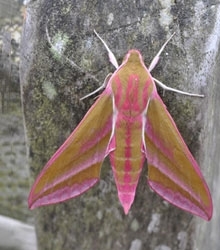Hawk moth
 Many people think of moths as rather boring little brown jobs that are a nuisance when they flutter around lights and charge headlong into candle flames – or, even worse, your gin and tonic! At best they are there to provide food for bats and at worst our clothes are there to provide food for them! However, try taking a closer look this summer. Yes, some are brown and rather nondescript, but many are spectacular – especially the hawk moth family.
Many people think of moths as rather boring little brown jobs that are a nuisance when they flutter around lights and charge headlong into candle flames – or, even worse, your gin and tonic! At best they are there to provide food for bats and at worst our clothes are there to provide food for them! However, try taking a closer look this summer. Yes, some are brown and rather nondescript, but many are spectacular – especially the hawk moth family.
There are 17 species of Hawkmoth in England, nine of which are resident and eight are migrants. This fact may surprise you in itself that many moths fly up from France, Spain and even North Africa to spend part of the summer within our shores. Hawk moths are large and often brightly coloured insects, the bigger ones measuring 50 to 60mm in length and their caterpillars growing to an incredible 100-130mm.
The Latin name for the hawk moth family is Sphingidae and this refers to the sphinx-like attitude that some of the caterpillars adopt when frightened or alarmed – where the head and thorax rear up, some even have coloured “eyes” to ward off predators. The other tell-tale sign of a hawk moth caterpillar is that it has a “hook” at the tail end.
The most common species to be found are the poplar, privet and elephant hawk moths. The first two named after the caterpillar’s food plant, the latter because of the extraordinary way the caterpillar can swell its thorax and “eyes” to resemble, yes, an elephant! Once you have seen an elephant hawk moth adult, you will never ever call moths “boring little brown jobs” again. They have pink and olive-green forewings and pink and black hindwings, which creates an insect that you would imagine exists in an equatorial forest rather than the UK. Although these three moths are probably the most common around here, there is one which you are more likely to see, as it flies during the day time.
The migrant hummingbird hawk moth is well named as it looks just like a little hummingbird, darting from plant to plant where it then hovers, feeding on the nectar. One of the main reasons I grow red valerian is to attract this species as it is a particular favourite for it to nectar on, others being jasmine, lobelia, petunia, honeysuckle and buddleias. Whenever I see this wonderful moth, I always feel rather uplifted to think that it has travelled from the Mediterranean region to feed in my garden, so I was interested to find out that many Europeans (especially the Italians and Maltese) believe that it is a messenger of good tidings. There is a lovely story of a “swarm” of these moths being spotted flying over the channel, headed to England from France on D-Day 1944, and all those who saw them returned safely to tell the tale.
The summer of 2004 saw particularly good numbers of these moths in our gardens all summer and even in a poor year I would expect to see at least one or two – so keep those eyes peeled!
The “king” of British hawk moths must, however, be the death’s head hawk moth – so called because of the skull and crossbones marking on its thorax – as portrayed in the film The Silence of the Lambs. This is our largest hawk moth and, when disturbed, makes an audible squeaking sound and has been known to visit wild bee nests to feed on the honey, the same squeaking noise apparently calming the bees. The food plant of this species is rather bizarrely, potatoes. Now you surely can’t call that a dull moth!
Peter Thompson
Advisory

Download Peter Thompson's essential 26-page book, featuring beautiful photography and detailed profiles of Britain's wildlife
Download FREE >